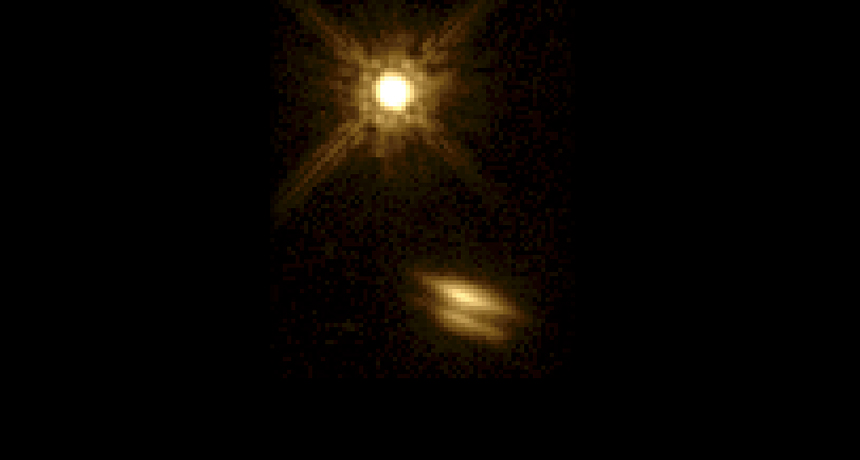
SIDE VIEW A disk of dust blocks light from one star (bottom) in HK Tauri, a binary system about 525 light-years away, in this image from the Hubble Space Telescope. New data reveal a disk, not visible in this picture, around the companion star (top).
Karl Stapelfeldt/JPL/NASA
- More than 2 years ago
Exoplanet orbits come in all shapes and sizes, and a pair of nearby stars is helping astronomers figure out why. Cockeyed disks of gas and dust that give rise to planets circle the two stars, new observations show. The misalignment between the two disks might nudge future planets into off-kilter orbits. Researchers hope that the discovery, the first time any one has observed disks with such different tilts, is the first step towards understanding the origin of the diverse planetary arrangements found in the galaxy.
Compared to some other planetary systems, the solar system is pretty dull. Earth and its siblings travel along nearly circular orbits in almost the same plane. A handful of planets around other stars are a bit more free-spirited. Some orbit at angles that are highly inclined relative to their star’s equator; some plunge in close to their sun before flying out to the backwaters of their system; still others carry the mass of Jupiter yet whip around their stars in mere days.
One leading idea to explain the odd orbits lays the blame on a second, nearby star. This hypothesis only works if the orbit of the second star is tilted relative to the disk in which planets form. Until now astronomers weren’t certain if this arrangement was possible. The new work shows that it is.
The disks around the stars in HK Tauri, a young binary system located just 525 light-years away in the constellation Taurus, are misaligned, astronomers Eric Jensen, of Swarthmore College in Pennsylvania, and Rachel Akeson, of Caltech, report in the July 31 Nature.
The researchers used the Atacama Large Millimeter/submillimeter Array in Chile, known as ALMA, to measure light emitted from carbon monoxide gas and microscopic dust grains, which revealed the orientations of the two rotating disks. The discovery implies that disks can form at odd angles relative to a stellar duo, creating conditions that are perfect for shaping the strange orbits of some planets.
Imagine a planet orbiting one of the stars in a binary pair, says Akeson. That planet will sense the gravity of its own star, but it will also feel a nudge from the second star. If the companion star lies above or below the plane of the planet’s orbit, gravity will finesse the planet into a path that more closely aligns with the two stars. The planet’s orbit will stretch as well. If the orbit becomes highly stretched, the host star can drag the planet into a much smaller orbit, which could explain the origin of some Jupiter-mass planets with tiny orbits.
According to some theories about binary star formation, the disks should form nicely aligned with each other. But, “there’s no way that’s true in this system,” Akeson says.
HK Tauri demonstrates that the binary-nudging mechanism can work, “but this can’t be the whole story,” Jensen says. There are many planets with eccentric, inclined orbits and many may have unseen binary companions — but probably not all of them. While some binaries may drift apart over time, leaving behind planets with odd orbits, interactions between planets might also scatter orbits.
Previously, researchers could get only limited information about disk orientation, which has prevented astronomers from testing some ideas about the formation of both planets and binary stars, notes Andrew Skemer, an astronomer at the University of Arizona in Tucson. Obtaining the orientation of both disks is “completely new,” he says. That was possible because ALMA is a sensitive telescope and can probe long wavelengths of light in which the disks appear much brighter.
Jensen and Akeson see this work as a first step towards refining ideas about planet formation. Now that they have demonstrated ALMA’s ability to see binary planet nurseries, the next step is to target many binaries and figure out how often disks are misaligned.







